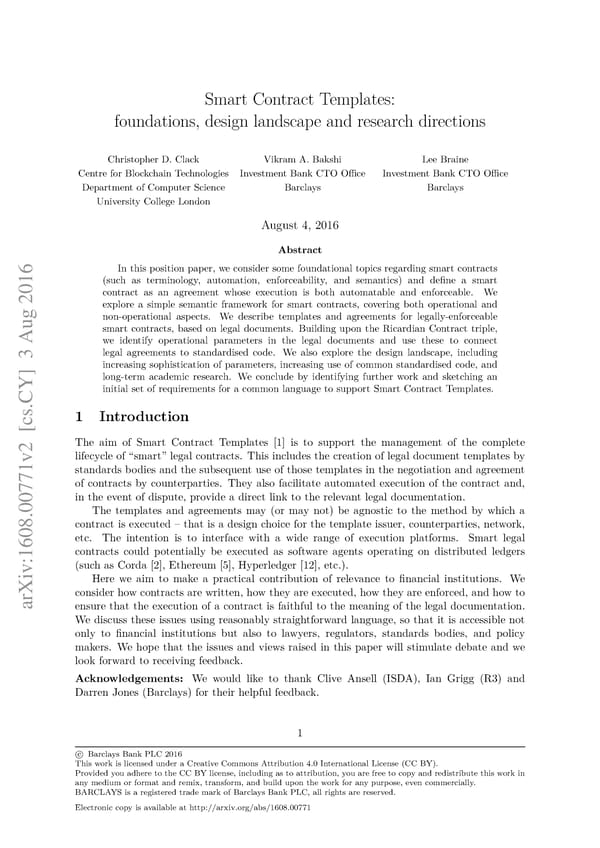Smart Contract Templates: foundations, design landscape and research directions Christopher D. Clack Vikram A. Bakshi Lee Braine Centre for Blockchain Technologies Investment Bank CTO Office Investment Bank CTO Office Department of Computer Science Barclays Barclays University College London August 4, 2016 Abstract In this position paper, we consider some foundational topics regarding smart contracts (such as terminology, automation, enforceability, and semantics) and define a smart contract as an agreement whose execution is both automatable and enforceable. We explore a simple semantic framework for smart contracts, covering both operational and non-operational aspects. We describe templates and agreements for legally-enforceable smart contracts, based on legal documents. Building upon the Ricardian Contract triple, we identify operational parameters in the legal documents and use these to connect legal agreements to standardised code. We also explore the design landscape, including increasing sophistication of parameters, increasing use of common standardised code, and long-term academic research. We conclude by identifying further work and sketching an initial set of requirements for a common language to support Smart Contract Templates. 1 Introduction The aim of Smart Contract Templates [1] is to support the management of the complete lifecycle of “smart” legal contracts. This includes the creation of legal document templates by standards bodies and the subsequent use of those templates in the negotiation and agreement of contracts by counterparties. They also facilitate automated execution of the contract and, in the event of dispute, provide a direct link to the relevant legal documentation. The templates and agreements may (or may not) be agnostic to the method by which a contract is executed – that is a design choice for the template issuer, counterparties, network, etc. The intention is to interface with a wide range of execution platforms. Smart legal contracts could potentially be executed as software agents operating on distributed ledgers (such as Corda [2], Ethereum [5], Hyperledger [12], etc.). Here we aim to make a practical contribution of relevance to financial institutions. We arXiv:1608.00771v2 [cs.CY] 3 Aug 2016consider how contracts are written, how they are executed, how they are enforced, and how to ensure that the execution of a contract is faithful to the meaning of the legal documentation. Wediscuss these issues using reasonably straightforward language, so that it is accessible not only to financial institutions but also to lawyers, regulators, standards bodies, and policy makers. We hope that the issues and views raised in this paper will stimulate debate and we look forward to receiving feedback. Acknowledgements: We would like to thank Clive Ansell (ISDA), Ian Grigg (R3) and Darren Jones (Barclays) for their helpful feedback. 1 c Barclays Bank PLC 2016 This work is licensed under a Creative Commons Attribution 4.0 International License (CC BY). Provided you adhere to the CC BY license, including as to attribution, you are free to copy and redistribute this work in any medium or format and remix, transform, and build upon the work for any purpose, even commercially. BARCLAYSis a registered trade mark of Barclays Bank PLC, all rights are reserved. Electronic copy is available at http://arxiv.org/abs/1608.00771
 Position Paper | Smart Contract Templates Page 1 Page 3
Position Paper | Smart Contract Templates Page 1 Page 3